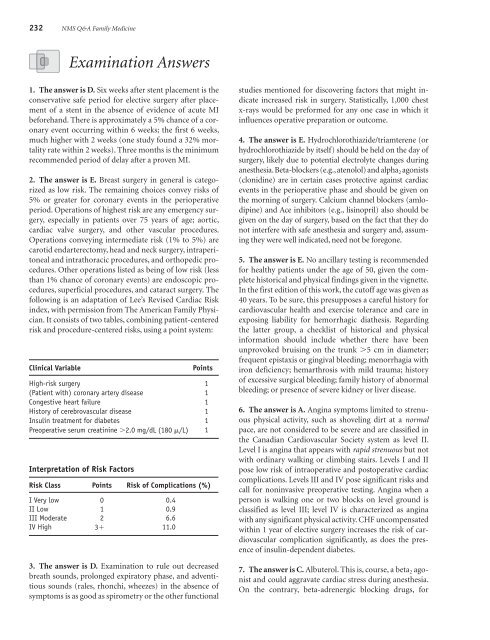NMS Q&A Family Medicine
NMS Q&A Family Medicine
NMS Q&A Family Medicine
- No tags were found...
Create successful ePaper yourself
Turn your PDF publications into a flip-book with our unique Google optimized e-Paper software.
232 <strong>NMS</strong> Q&A <strong>Family</strong> <strong>Medicine</strong>Examination Answers1. The answer is D. Six weeks after stent placement is theconservative safe period for elective surgery after placementof a stent in the absence of evidence of acute MIbeforehand. There is approximately a 5% chance of a coronaryevent occurring within 6 weeks; the first 6 weeks,much higher with 2 weeks (one study found a 32% mortalityrate within 2 weeks). Three months is the minimumrecommended period of delay after a proven MI.2. The answer is E. Breast surgery in general is categorizedas low risk. The remaining choices convey risks of5% or greater for coronary events in the perioperativeperiod. Operations of highest risk are any emergency surgery,especially in patients over 75 years of age; aortic,cardiac valve surgery, and other vascular procedures.Operations conveying intermediate risk (1% to 5%) arecarotid endarterectomy, head and neck surgery, intraperitonealand intrathoracic procedures, and orthopedic procedures.Other operations listed as being of low risk (lessthan 1% chance of coronary events) are endoscopic procedures,superficial procedures, and cataract surgery. Thefollowing is an adaptation of Lee’s Revised Cardiac Riskindex, with permission from The American <strong>Family</strong> Physician.It consists of two tables, combining patient-centeredrisk and procedure-centered risks, using a point system:Clinical VariablePointsHigh-risk surgery 1(Patient with) coronary artery disease 1Congestive heart failure 1History of cerebrovascular disease 1Insulin treatment for diabetes 1Preoperative serum creatinine 2.0 mg/dL (180 /L) 1Interpretation of Risk FactorsRisk Class Points Risk of Complications (%)I Very low 0 0.4II Low 1 0.9III Moderate 2 6.6IV High 3 11.03. The answer is D. Examination to rule out decreasedbreath sounds, prolonged expiratory phase, and adventitioussounds (rales, rhonchi, wheezes) in the absence ofsymptoms is as good as spirometry or the other functionalstudies mentioned for discovering factors that might indicateincreased risk in surgery. Statistically, 1,000 chestx-rays would be preformed for any one case in which itinfluences operative preparation or outcome.4. The answer is E. Hydrochlorothiazide/triamterene (orhydrochlorothiazide by itself) should be held on the day ofsurgery, likely due to potential electrolyte changes duringanesthesia. Beta-blockers (e.g., atenolol) and alpha 2 agonists(clonidine) are in certain cases protective against cardiacevents in the perioperative phase and should be given onthe morning of surgery. Calcium channel blockers (amlodipine)and Ace inhibitors (e.g., lisinopril) also should begiven on the day of surgery, based on the fact that they donot interfere with safe anesthesia and surgery and, assumingthey were well indicated, need not be foregone.5. The answer is E. No ancillary testing is recommendedfor healthy patients under the age of 50, given the completehistorical and physical findings given in the vignette.In the first edition of this work, the cutoff age was given as40 years. To be sure, this presupposes a careful history forcardiovascular health and exercise tolerance and care inexposing liability for hemorrhagic diathesis. Regardingthe latter group, a checklist of historical and physicalinformation should include whether there have beenunprovoked bruising on the trunk 5 cm in diameter;frequent epistaxis or gingival bleeding; menorrhagia withiron deficiency; hemarthrosis with mild trauma; historyof excessive surgical bleeding; family history of abnormalbleeding; or presence of severe kidney or liver disease.6. The answer is A. Angina symptoms limited to strenuousphysical activity, such as shoveling dirt at a normalpace, are not considered to be severe and are classified inthe Canadian Cardiovascular Society system as level II.Level I is angina that appears with rapid strenuous but notwith ordinary walking or climbing stairs. Levels I and IIpose low risk of intraoperative and postoperative cardiaccomplications. Levels III and IV pose significant risks andcall for noninvasive preoperative testing. Angina when aperson is walking one or two blocks on level ground isclassified as level III; level IV is characterized as anginawith any significant physical activity. CHF uncompensatedwithin 1 year of elective surgery increases the risk of cardiovascularcomplication significantly, as does the presenceof insulin-dependent diabetes.7. The answer is C. Albuterol. This is, course, a beta 2 agonistand could aggravate cardiac stress during anesthesia.On the contrary, beta-adrenergic blocking drugs, for
















